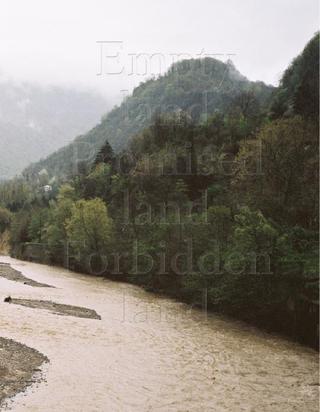15 February 2011
Book review: Empty land Promised land Forbidden land by Rob Hornstra and Arnold van Bruggen
 Empty land Promised land Forbidden land
Rob Hornstra and Arnold van Bruggen
Empty land Promised land Forbidden land
Rob Hornstra and Arnold van Bruggen
The Sochi Project
November 2010
272 pages
This is an unusual book. It is a book about Abkhazia, which in itself is rare enough. What is more, it is not academic conflict literature. Still more remarkable, it attempts to combine two genres, being a travel book on the one hand and a flashy photo book on the other. And it was published without a traditional publisher.
Its authors are Rob Hornstra, who did the photography, and Arnold van Bruggen, who was responsible for the text. Together they form The Sochi Project. Theirs is an ambitious project. In the run-up to the 2014 Sochi Olympic Winter Games, Hornstra and van Bruggen are reporting from the region, financed by private donors, and every year they are releasing a book about a specific topic — this year Abkhazia.
With such an innovative concept, a lot might have gone wrong. But Empty land Promised land Forbidden land is a success. There are occasional typos, of the kind not detectable by a spell check (e.g. Cold Wall for Cold War on page 55). And some of the background information is mistaken, like when it is said on page 30 that the National Archive of Abkhazia was burned by Georgian soldiers while they were retreating, when instead it was an organised act perpetrated shortly after the beginning of the Georgian occupation of Sukhum. But these are minor irritants, and the book comes out better in this respect than some others, conventionally published yet poorly edited. The overall presentation of Empty land Promised land Forbidden land is very good, and the book itself is a marvel to behold, with the title embossed into its cover.
So how does it hold up as a photo book on the one hand and a travel book on the other?
The book's photos are of two types. Most prominently, there are big page-filling photos grouped together at the beginning and end of each chapter. The quality of these photos is invariably very high, and my only complaint is that their subject-matter predominantly gloomy — there are many photos of ruins, photos of lost loved ones and serious people in offices. Decay can be very beautiful, and there is a lot of decay in Abkhazia, so there is a definite place for these topics in any photo documentary of Abkhazia. But from the photos in this book, one could get the impression that Abkhazia is a war-ravaged Soviet holdout where time has stood still over the past 15 years. And while that is of course partially true, the photos insufficiently reflect the fact that at least a part of Abkhazia has moved on. There are no photos which show the hordes of Russian tourists (for better or worse), the beautiful nature that attracts them or the parts of Sukhum's city centre which have been very attractively restored.
There are also smaller black-and-white photos within the text, whose major purpose is to illustrate the narrative. Regrettably, some of these photos are very difficult to make out due their small size and their black-and-white nature.
Empty land Promised land Forbidden land is not an academic treatise, but a travel book. Consequently, it does not approach its subject matter from the 'outside'. It is not an exposé written by an expert, guided by a set of research questions and equipped with a clear structure geared towards answering these questions, starting with a historical background section. Rather, it is written from 'within', by two travellers who share their experiences as they discover Abkhazia, taking the reader with them on their journey, not knowing themselves where exactly this journey will take them. The reporting is straightforward: calling spades spades and refreshingly apolitical. This format is exactly right for introducing readers to the people behind the conflict, and for showing that Abkhazia is a society with its own voices, desires and troubles. While the claim — made at the book presentation — that Empty land Promised land Forbidden land leaves no aspect of Abkhazia undiscussed was an exaggeration, the book does cover a wealth of topics and viewpoints. Especially recommendable in this regard are the sections where the authors visit the Georgian refugees, the Abkhazian diaspora in Turkey and the Abazins in Russia. There are also some hilarious highlights, including a visit to the dentist for root canal treatment.
Another claim made at the book presentation was that Empty land Promised land Forbidden land is rare for being such a successful fusion of photo book and travel book, integrating both halves without making either subservient to the other. I am not in a position to judge how Empty land Promised land Forbidden land compares with other efforts in this genre, but its two halves are indeed well-balanced and well-integrated. The photos can stand on their own, but they also illustrate passages from the running text, via an efficient referencing system. (Regrettably though, the photos do not refer back to the text, which would have been useful given that photos and text are sometimes quite far apart.)
Since Empty land Promised land Forbidden land is not being published conventionally, it may be a bit difficult to acquire. But it can be ordered through the website of The Sochi Project, or bought at a number of book stores (across the world) listed there. Empty land Promised land Forbidden land is well worth its price (€49,–). Its print run is only 1000 — but hopefully it reaches a second print run.